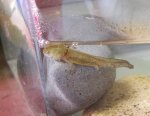Hello everyone,
I've posted an introduction on the intros page and was hoping I could get some help with my salamander. He/she was found in a quickly emptying pond a few weeks ago and has since been living in a tank on my patio. It ate all the other salamanders that were in the tank with it (except one who has now been separated). He (the big one) seems to be doing really well (from what I can tell). I have a whole lot of questions about his care but thought I should start with figuring out what kind of creature he is before progressing any further. I've attached a photo, he's about 1.25" long at this point and has almost doubled in size in the past three weeks.
I'm also worried that since he has eaten all of the other salamanders he doesn't seem very interested in other food I've offered. Until they became lunch themselves the others seemed happy feasting on bloodworms, but this guy isn't interested. I've also tried mealworms but they seem to drown before he's interested. Any help or advice would be greatly appreciated. Thanks so much!
Lauren
I've posted an introduction on the intros page and was hoping I could get some help with my salamander. He/she was found in a quickly emptying pond a few weeks ago and has since been living in a tank on my patio. It ate all the other salamanders that were in the tank with it (except one who has now been separated). He (the big one) seems to be doing really well (from what I can tell). I have a whole lot of questions about his care but thought I should start with figuring out what kind of creature he is before progressing any further. I've attached a photo, he's about 1.25" long at this point and has almost doubled in size in the past three weeks.
I'm also worried that since he has eaten all of the other salamanders he doesn't seem very interested in other food I've offered. Until they became lunch themselves the others seemed happy feasting on bloodworms, but this guy isn't interested. I've also tried mealworms but they seem to drown before he's interested. Any help or advice would be greatly appreciated. Thanks so much!
Lauren

